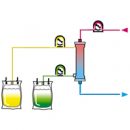Polycystic kidney - Serious hereditary disease. So serious that it is capable of leading out. From this article you will learn what kind of kidney polycystosis is why he arises and what are his signs.
Content
What is polycystic kidney
How and why polycystic kidney disease occurs
Signs of polycystic kidney
 Polycystosis most often gives itself not immediately. As a rule, the expanded painting of the disease occurs to 45-65 years. Although children also have a manifestation of polycystic. However, during the intrauterine development of polycystrosis, spontaneous abortions or stillbirth may occur. Polycystosis - the disease is hereditary and manifests itself, except in cases where a person simply does not live up to that age when the disease usually arises.
Polycystosis most often gives itself not immediately. As a rule, the expanded painting of the disease occurs to 45-65 years. Although children also have a manifestation of polycystic. However, during the intrauterine development of polycystrosis, spontaneous abortions or stillbirth may occur. Polycystosis - the disease is hereditary and manifests itself, except in cases where a person simply does not live up to that age when the disease usually arises.Manifestations of disease numerous. There is a bilateral increase in kidneys in the amount, pain, as well as a number of complications that appear not immediately - bleeding, the formation of stones, an increase in blood pressure, urinary tract infection and, finally, the most important thing - chronic renal failure.
Pain occurs due to the stretching of the kidney fabric by numerous cysts. Usually painful sensations are bothering in the lumbar region and in the side. Bleeding and blood appearance in the urine (hematuria) is associated with bleeding arising inside the cyst. Such bleeding can be both insignificant and quite powerful, which often requires immediate surgery.
In the diagnosis of polycystrosis, the examination of the patient is of great importance, finding out its complaints, as well as the clarification of the presence of such a disease in blood relatives. In order to prove the presence of polycystosis requires a number of studies. The most commonly carried out ultrasound examination, intravenous urography (the study of the kidneys and urinary tract using X-ray examination using a contrast substance) and computed tomography, which is the most valuable study method for polycystic.
According to the materials of the article «What is polycystic kidney».









